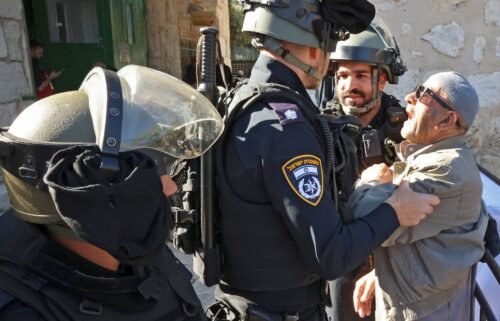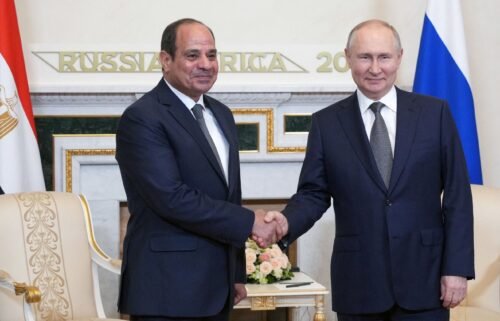Russia’s militarization of the Arctic shows no sign of slowing down
By Nick Paton Walsh and Sarah Dean, CNN
Russia has continued expanding its military bases in the Arctic region despite significant losses in its war on Ukraine, according to a new series of satellite images obtained by CNN.
NATO Secretary General Jens Stoltenberg also told CNN in an exclusive interview on Friday there is now “a significant Russian military build-up in the high north,” with recent tensions causing the alliance to “double its presence” in response.
The findings also come as a senior Western intelligence official told CNN Russia has withdrawn as much as three quarters of its land forces from the High North region near the Arctic, sending them to bolster its faltering invasion of its neighbor, Ukraine.
The satellite pictures, obtained by CNN from Maxar Technologies, show a series of Russian radar bases and runways undergoing improvements over the past year. The images do not show dramatic development, but rather the continued progress of fortifying and expanding an area analysts say is of vital importance to Russia’s defensive strategy, at a time of great strain on Moscow’s resources.
According to Maxar, the images demonstrate continued work on the radar stations at the Olenegorsk site, on the Kola Peninsula in northwest Russia, and at Vorkuta, just north of the Arctic circle. They also appear to show work moving ahead to complete one of five Rezonans-N radar systems at Ostrovnoy, a site located by the Barents Sea, near Norway and Finland in Russia’s west. The Rezonans-N are claimed by Russian officials to be able to detect stealth aircraft and objects.
Three new radomes, the weatherproof enclosures used to protect radar antennas, were completed this year at the Tiksi air defense site, in the far northeast, according to Maxar’s images and analysis. There are also improvements to a runway and parking apron at Nagurskoye air base — Russia’s northernmost military facility — and runway improvements at ‘Temp’ air base, on Kotelny Island, in the northeast of the country.
Russia has been bolstering its defenses in the far north for years, refurbishing a series of old Soviet bases with modern designs and equipment.
Its Arctic region has long been key to its oil and gas sector, but also to its nuclear defenses, with a significant proportion of its sophisticated nuclear weaponry and submarine facilities in that area.
“That deterrence has always been ready,” said a senior Western intelligence official. “It’s never down to low readiness; it’s a high status all the time,” the official said.
At the start of the war with Ukraine in February some submarines were repositioned to signal “this is a real capability,” the official added, but they soon returned to standard high readiness.
NATO chief Stoltenberg reasoned: “The shortest way from Russia to North America is over the Arctic North Pole. So the strategic importance of these areas has not changed because of the war in Ukraine.”
“We see Russia reopening old Soviet bases, military sites,” he said, noting that it is also “testing novel weapons in the Arctic and the high north.”
“It is significant that they have managed to shelter this area from the impact of the Ukrainian war”, said Malte Humpert of the Arctic Institute, who has written extensively on the development of the Arctic.
“They are prioritising energy resources in the Arctic, but another aspect is to project power. Yet this is also economic. About 20% of Russia’s GDP comes from the Arctic area, and that may be more in the future. There is a lot of money involved in the area for them.”
The war in Ukraine has led to a major adjustment in Russia’s troop strengths in the region, the senior Western intelligence official said. “They’re down to somewhere between 20 and 25% of their original land forces up there. But then the naval component is totally untouched by the war,” they noted.
Following strikes earlier this month on two key airfields deep inside Russia in Ryazan and Saratov, Russian military jets and bombers have been dispersed across the country and the Arctic north, the official added. Moscow has blamed the strikes on Ukraine, while Kyiv has offered no comment on the explosions at the Russian bases.
The Arctic is also vital to Russia because its melting ice is rapidly opening up new shipping routes from Asia’s southeast to Europe, using a much shorter path along the Russian coast.
The Northern Sea Route could cut around two weeks off the current journey time across the Suez Canal. Russian state TV has reveled in the launch of several atomic-powered icebreakers, designed to boost Russian influence and power in the region. Critics say Moscow is seeking to exert outsized control over a route that should be equally accessible to all nations.
Speaking via videolink at the launch of a new nuclear-powered icebreaker in St. Petersburg last month (November 22), Russian President Vladimir Putin said the development of the “most important” Northern Sea Route “will allow Russia to fully reveal its export potential and to establish effective logistics routes, including to southeast Asia.”
At the same time, the war in Ukraine has boosted NATO’s presence in the region. Once Finland and Sweden join the block, as is widely expected, seven out of eight Arctic states will be NATO members.
The alliance has also ramped up its military clout in the region. In August, Norway released the first images of US B52 bombers flying over its territory escorted by Norwegian F35 jets and 2 Swedish JAS Gripen.
Increased signaling by NATO included a recent test of the new weapons system, the Rapid Dragon Palletized Munition Deployment, involving a complex drop by US special forces of a normal supply pallet from the back of a C130 cargo craft.
The pallet contains a cruise missile, which launches as the pallet falls by parachute. The display was designed to show the United States can launch these powerful weapons systems from the back of an ordinary cargo plane. The test took place in Norway, not far from the Russian border.
NATO has also become increasingly concerned about the potential sabotage of Norway’s oil and gas infrastructure. Now Russian energy is subject to sanctions, Norway’s natural gas makes up more than 20% of Europe’s supply, according to some analysis.
“Since the sabotage in the Baltic Sea,” Stoltenberg said, “we have doubled our presence, with ships, with submarines, with maritime patrol aircrafts in the Baltic and North Seas, partly to monitor, to have better situational awareness, but also to send a message of deterrence and readiness to protect this critical infrastructure.” The NATO head was referring to the blasts at the Nord Stream pipeline in September, which were caused by an act of sabotage, according to Swedish prosecutors, after evidence of explosives was discovered at the sites.
The senior intelligence official said, however, that a recent Norwegian review of its infrastructure security concluded no major attempts to attack it had occurred and that “the oil infrastructure is well secured now.”
The-CNN-Wire
™ & © 2022 Cable News Network, Inc., a Warner Bros. Discovery Company. All rights reserved.


